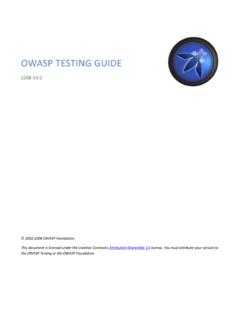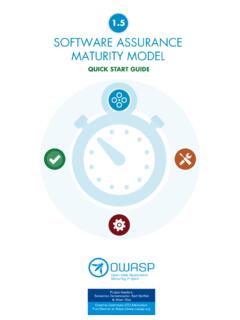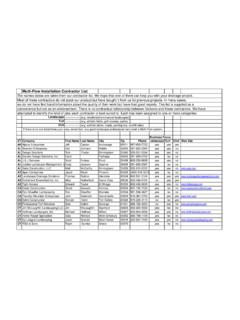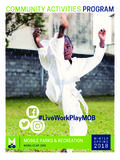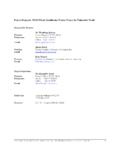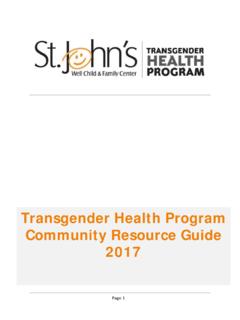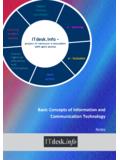Transcription of OWASP Top 10 - 2017
1 Release Candidate 2 Comments requested perinstructions withinOWASP Top 10 2017 The Ten Most Critical Web Application Security RisksThis work is licensed under aCreative Commons Attribution-ShareAlike International NoticeRequest for CommentsThis version is not a final first release candidate received a great deal of push back, which caused a leadership change, involving the community in re-evaluating what the OWASP Top 10 is, the methodology, the data collection and analysis, and how we provide transparency and governance over the project. Most of all, the push back showed us how much passion the community has for the OWASP Top 10, and thus how critical it is for OWASP to get the Top 10 right for the majority of use have worked extensively to validate the methodology, obtained a great deal of data on over 114,000 apps, and obtained qualitative data via survey by 550 community members on the two new categories insecure deserialization and insufficient logging and strongly urge for any corrections or issues to be logged at GitHub public transparency, we provide traceability and ensure that all voices are heard during this final month before publication.
2 Andrew van der Stock Brian Glas Neil Smithline Torsten GiglerRCRelease Candidate2 Copyright and LicenseCopyright 2003 2017 The OWASP FoundationThis document is released under the Creative Commons Attribution Share-Alike license. For any reuse or distribution, you must make it clear to others the license terms of this of ContentsAbout OWASPThe Open Web Application Security Project ( OWASP ) is an open community dedicated to enabling organizations to develop, purchase, and maintain applications and APIs that can be trusted. At OWASP you'll find free and open Application security tools and standards Complete books on application security testing, secure code development, and secure code review Presentations and videos Cheat sheets on many common topics Standard security controls and libraries Local chapters worldwide Cutting edge research Extensive conferences worldwide Mailing listsLearn more at: of the OWASP tools, documents, videos, presentations, and chapters are free and open to anyone interested in improving application security.
3 We advocate approaching application security as a people, process, and technology problem, because the most effective approaches to application security require improvements in these is a new kind of organization. Our freedom from commercial pressures allows us to provide unbiased, practical, cost-effective information about application security. OWASP is not affiliated with any technology company, although we support the informed use of commercial security technology. OWASP produces many types of materials in a collaborative, transparent and open OWASP Foundation is the non-profit entity that ensures the project's long-term success. Almost everyone associated with OWASP is a volunteer, including the OWASP Board, Chapter Leaders, Project Leaders, and project members. We support innovative security research with grants and join us!TOCT able of ContentsTOC-About ..4RN-Release Notes ..5 Risk-Application Security Risks.
4 6T10- OWASP Top 10 Application Security-Risks :2017-Broken :2017-Sensitive Data :2017-XML External Entities (XXE) ..11A5:2017-Broken Access Control ..12A6:2017-Security :2017-Cross-Site Scripting (XSS) ..14A8:2017-Insecure :2017-Using Components with Known-Vulnerabilities ..16A10:2017-Insufficient Logging & +D-What s Next for +T-What s Next for Security +O-What s Next for +A-What s Next for Application +R-Note About +RF-Details About Risk +Dat-Methodology and + software is undermining our financial, healthcare, defense, energy, and other critical infrastructure. As our software becomes increasingly critical, complex, and connected, the difficulty of achieving application security increases exponentially. The rapid pace of modern software development processes makes risks even more critical to discover quickly and accurately. We can no longer afford to tolerate relatively simple security problems like those presented in this OWASP Top great deal of feedback was received during the creation of the OWASP Top 10 2017, more than for any other equivalent OWASP effort.
5 This shows how much passion the community has for the OWASP Top 10, and thus how critical it is for OWASP to get the Top 10 right for the majority of use the original goal of the OWASP Top 10 project was simply to raise awareness amongst developers, it has become thede facto application security have taken steps in this release to firm up the definition of issues, and improve the recommendations to be leading practices that may be adopted as an application security standard that covers off around 80-90% of all common attacks and threats. We encourage large and high performing organizations to use the OWASP Application Security Verification Standardif a true standard is required, but for most, the OWASP Top 10 is a great start on the application security have written up a range of suggested next steps for different users of the OWASP Top 10, including "What's next for developers", "What's next for testers", "What's next for organizations" which is suitable for CIO's and CISO's, "What's next for application managers", which is suitable for application the long term, we encourage all software development teams and organizations to create an application security program that is compatible with your culture and technology.
6 These programs come in all shapes and sizes. Leverage your organization's existing strengths to do and measure what works for hope that the OWASP Top 10 is useful to your application security efforts. Please don't hesitate to contact OWASP with your questions, comments, and ideas at our GitHub project repository: can find OWASP Top 10 project and translations here: , we wish to thank the founding leadership of the OWASP Top 10 project, Dave Wichers and Jeff Williams for all their efforts, and believing in us to get this finished with the community's help. Thank you! Torsten Gigler Brian Glas Neil Smithline Andrew van der Stock4 Roadmap for future activitiesDon' ' 'scode, What'sNextForDevelopers,Testers,andOrgan izations 'rereadytostopchasingvulnerabilitiesandf ocusonestablishingstrongapplicationsecur itycontrols, OWASP ismaintainingandpromotingtheOWASPA pplicationSecurityVerificationStandard(A SVS) , left, right, and everywhere.
7 Focus on making security an integral part of your culture throughout your development organization. Find out more in the OWASP Software Assurance Maturity Model (OpenSAMM).AttributionWe' ,allthedatacontributedtoaTop10release,an dthefulllistofcontributors, , , ,notesofencouragement(andcriticisms), would like to thank in advance those individuals who contribute significant constructive comments and time reviewing this update to the Top 10. As much as possible, we have listed them on the attribution page +Ack .And finally, we'd like to thank in advance all the translators out there that will translate this release of the Top 10 into numerous different languages, helping to make the OWASP Top 10 more accessible to the entire the OWASP Top 10 2017! This major update adds several new issues, including two issues selected by the community -A8:2017-Insecure Deserialization andA10:2017-Insufficient logging and monitoring. Community feedback drove the collection of the most amount of data ever assembled in the preparation of an application security standard, and so we are confident that the remaining 8 issues are the most important for organizations to address, particularly the A3:2017-Exposure of Sensitive Data in the age of the EU's General Data Protection Regulation, A6:2017-Security Misconfiguration especially around cloud and API services, and A9:2017 Using Components with Known Vulnerabilities, which can be especially challenging for those on modern platforms, like OWASP Top 10 for 2017 is based primarily on 40+ data submissions from firms that specialize in application security and an industry survey that wascompleted by 515 individuals.
8 This data spans vulnerabilities gathered from hundreds of organizations and over 100,000 real-world applications and APIs. The Top 10 items are selected and prioritized according to this prevalence data, in combination with consensus estimates of exploitability, detectability, and primary aim of the OWASP Top 10 is to educate developers, designers, architects, managers, and organizations about the consequences of the most common and most important web application security weaknesses. The Top 10 provides basic techniques to protect against these high risk problem areas, and provides guidance on where to go from changed from 2013 to 2017?Change has accelerated over the last four years, and the OWASP Top 10 needed to change. We've completely refactored the OWASP Top 10, revamped the methodology, utilized a new data call process, worked with the community, re-ordered our risks, re-written each risk from the ground up, and added references to frameworks and languages that are now commonly the last decade, and in particularly these last few years, the fundamental architecture of applications has changed significantly: JavaScript is now the primary language of the web.
9 And modern web frameworks such as Bootstrap, Electron, Angular, React amongst many others, means source that was once on the server is now running on untrusted browsers. Single page applications, written in JavaScript frameworks such as Angular and React, allow the creation of highly modular frontend user experiences, not to mention the rise and rise of mobile apps using the same APIs as single page apps Microservices written in and Spring Boot are replacing older enterprise service bus applications using EJBs and so on. Old code that never expected to be communicated with directly from the Internet is now sitting behind an API or RESTful web assumptions that underlie this code, such as trusted callers, are simply not issues, supported by data A4:2017 XML External Entity (XXE) is a new category primarily supported by SAST data issues, supported by the communityWe asked the community to provide insight into two forward looking weakness categories.
10 After 516 peer submissions, andremoving issues that were already supported by data (such as Sensitive Data Exposure and XXE), the two new issues are A8:2017-Insecure Deserialization, responsible for one of the worst breaches of all time, and A10:2017-Insufficient Logging and Monitoring, the lack of which can prevent or significantly delay malicious activity and breachdetection, incident response and digital , but not forgotten A4 Insecure direct object references and A7 Missing function level access control merged into A5:2017-Broken Access Control. A8 CSRF. Less than 5% of the data set supports CSRF today, which places it around #13 A10 Unvalidated redirects and forwards. Less than 1% of the data set supports this issue today, as it s now #25 RNRelease NotesOWASP Top 10 2013 OWASP Top 10 2017A1 Injection A1:2017 InjectionA2 Broken Authentication and Session Management A2:2017 Broken Authentication and Session ManagementA3 Cross-Site Scripting (XSS) A3:2013 Sensitive Data ExposureA4 Insecure Direct Object References [Merged+A7] A4:2017 XML External Entity (XXE) [NEW]A5 Security Misconfiguration A5:2017 Broken Access Control [Merged]A6 Sensitive Data Exposure A6:2017 Security MisconfigurationA7 MissingFunctionLevelAccessContr [Merged+A4] A7:2017 Cross-Site Scripting (XSS)A8 Cross-Site Request Forgery (CSRF) A8:2017 Insecure Deserialization [NEW, Community]A9 Using Components with Known Vulnerabilities A9:2017 Using Components with Known VulnerabilitiesA10 Unvalidated Redirects and Forwards A10:2017 InsufficientLogging&Monitoring[NEW,Comm. ]




